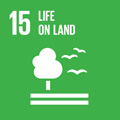- Docente: Riccardo Testolin
- Credits: 4
- SSD: BIO/03
- Language: Italian
- Teaching Mode: Traditional lectures
- Campus: Bologna
-
Corso:
First cycle degree programme (L) in
Natural Sciences (cod. 5823)
Also valid for First cycle degree programme (L) in Natural Sciences (cod. 8016)
Learning outcomes
At the end of the course, the student has an overall view of habitats with different degrees of naturalness/artificiality, described through vegetation characters and the methods to be adopted for their description, with reference to European regulations. A particular focus concerns the problems resulting from the anthropic impact.
Course contents
Conservation of plant biodiversity
Theoretical bases on the conservation of ecosystems. International and European conventions on nature conservation.
Protected areas at European, national and regional level.
Examples of protected habitats particularly widespread in Italy and in the regional territory.
Habitat classification systems.
Acquired knowledge
Knowledge of the main nature protection systems in Italy and in Europe. Knowledge of specific habitats of the regional territory. Knowledge of the main codified systems for the description of biodiversity.
Threats to biodiversity and its restoration
Biodiversity and spatial scale.
Measures of biodiversity: indices and estimators.
Threats to biodiversity and their effects.
Principles of environmental restoration.
Acquired knowledge
Knowledge of the different concepts of biodiversity and of the indices for its quantitative evaluation. Knowledge of the main threats to biodiversity conservation. Acquisition of the principles of environmental restoration.
Field excursions
The course includes three one-day trips to visit some of the habitats described in class.
Readings/Bibliography
The teacher will provide the pdf of texts, monographs and scientific articles on each of the topics covered in class, in addition to the pdf of each lesson once the topic is completed.
The reference texts for the course include:
Giacomini, Valerio. The flora. Know Italy Vol. 2. Italian Touring Club, 1958
Quaderni Habitat: https://www.mase.gov.it/pagina/i-quaderni-habitat-collana
Magurran, A E.; McGill, BJ (ed.). Biological diversity: frontiers in measurement and assessment. OUP Oxford, 2010.
Van Andel, Jelte, and James Aronson, eds. Restoration ecology: the new frontier. John Wiley & Sons, 2012.
Not all of the content of the recommended texts is actually to be considered for the preparation of the exam, and the purchase of the volumes is not recommended. The student will then have to select among the topics covered in the texts, those that are the object of study for the preparation of the exam, referring to what is indicated in detail in the program.
Most of the texts are available for consultation at the University libraries.
Teaching methods
The course is mainly carried out through (i) lectures with video projection and (ii) educational excursions aimed at getting to know some of the main regional habitats described in class under the guidance of the teacher and any collaborators. These teaching methodologies can be integrated with the organization of seminar meetings with technicians who are experts in specific topics of the teaching programme.
In consideration of the types of activities and teaching methods adopted, the attendance of this training activity requires that all students carry out in e-learning mode [https://www.unibo.it/it/servizi-e-opportunita/salute- e-assistance/health-and-safety/safety-and-health-in-places-of-study-and-traineeship] and participation in module 3 of specific training on safety and health in places of study. Information on dates and methods of attendance of module 3 can be consulted in the appropriate section of the study course website.
Assessment methods
The assessment test is oral and includes the discussion of the topics covered in class and during the educational excursions.
The evaluation is based on the individual student's knowledge of the topics in the program and on the quality of the presentation. The duration of the oral exam is on average 30 minutes.
Teaching tools
Presentations of the lessons held by the teacher, publications and scientific reports provided by the teacher, specialized websites, PC, video projector.
All teaching material is made available to students in advance through the Virtual portal (virtuale.unibo.it).
Office hours
See the website of Riccardo Testolin
SDGs

This teaching activity contributes to the achievement of the Sustainable Development Goals of the UN 2030 Agenda.
